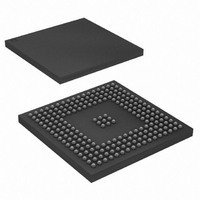AT91SAM9XE256-CU Atmel, AT91SAM9XE256-CU Datasheet - Page 519

AT91SAM9XE256-CU
Manufacturer Part Number
AT91SAM9XE256-CU
Description
MCU ARM9 256K FLASH 217-BGA
Manufacturer
Atmel
Series
AT91SAMr
Specifications of AT91SAM9XE256-CU
Core Processor
ARM9
Core Size
16/32-Bit
Speed
180MHz
Connectivity
EBI/EMI, Ethernet, I²C, MMC, SPI, SSC, UART/USART, USB
Peripherals
Brown-out Detect/Reset, POR, PWM, WDT
Number Of I /o
96
Program Memory Size
256KB (256K x 8)
Program Memory Type
FLASH
Ram Size
56K x 8
Voltage - Supply (vcc/vdd)
1.65 V ~ 1.95 V
Data Converters
A/D 4x10b
Oscillator Type
Internal
Operating Temperature
-40°C ~ 85°C
Package / Case
217-LFBGA
Processor Series
AT91SAMx
Core
ARM926EJ-S
Data Bus Width
32 bit
Data Ram Size
32 KB
Interface Type
2-Wire, EBI, I2S, SPI, USART
Maximum Clock Frequency
180 MHz
Number Of Programmable I/os
96
Number Of Timers
6
Maximum Operating Temperature
+ 85 C
Mounting Style
SMD/SMT
3rd Party Development Tools
JTRACE-ARM-2M, KSK-AT91SAM9XE-PL, MDK-ARM, RL-ARM, ULINK2
Development Tools By Supplier
AT91SAM-ICE, AT91-ISP, AT91SAM9XE-EK
Minimum Operating Temperature
- 40 C
On-chip Adc
10 bit, 4 Channel
Package
217LFBGA
Device Core
ARM926EJ-S
Family Name
91S
Maximum Speed
180 MHz
Operating Supply Voltage
1.8|2.5|3.3 V
For Use With
AT91SAM9XE-EK - KIT EVAL FOR AT91SAM9XEAT91SAM-ICE - EMULATOR FOR AT91 ARM7/ARM9
Lead Free Status / RoHS Status
Lead free / RoHS Compliant
Eeprom Size
-
Lead Free Status / Rohs Status
Lead free / RoHS Compliant
Available stocks
Company
Part Number
Manufacturer
Quantity
Price
Company:
Part Number:
AT91SAM9XE256-CU
Manufacturer:
ATMEL
Quantity:
215
- Current page: 519 of 860
- Download datasheet (13Mb)
Figure 34-31. T = 0 Protocol without Parity Error
Figure 34-32. T = 0 Protocol with Parity Error
34.6.4.3
34.6.4.4
34.6.4.5
6254C–ATARM–22-Jan-10
Baud Rate
Baud Rate
Clock
I/O
Clock
RXD
Receive Error Counter
Receive NACK Inhibit
Transmit Character Repetition
Start
Bit
Start
Bit
D0
If a parity error is detected by the receiver, it drives the I/O line at 0 during the guard time, as
shown in
the character lasts 1 bit time more, as the guard time length is the same and is added to the
error bit time which lasts 1 bit time.
When the USART is the receiver and it detects an error, it does not load the erroneous character
in the Receive Holding Register (US_RHR). It appropriately sets the PARE bit in the Status Reg-
ister (US_SR) so that the software can handle the error.
The USART receiver also records the total number of errors. This can be read in the Number of
Error (US_NER) register. The NB_ERRORS field can record up to 255 errors. Reading US_NER
automatically clears the NB_ERRORS field.
The USART can also be configured to inhibit an error. This can be achieved by setting the
INACK bit in the Mode Register (US_MR). If INACK is at 1, no error signal is driven on the I/O
line even if a parity bit is detected, but the INACK bit is set in the Status Register (US_SR). The
INACK bit can be cleared by writing the Control Register (US_CR) with the RSTNACK bit at 1.
Moreover, if INACK is set, the erroneous received character is stored in the Receive Holding
Register, as if no error occurred. However, the RXRDY bit does not raise.
When the USART is transmitting a character and gets a NACK, it can automatically repeat the
character before moving on to the next one. Repetition is enabled by writing the
MAX_ITERATION field in the Mode Register (US_MR) at a value higher than 0. Each character
can be transmitted up to eight times; the first transmission plus seven repetitions.
If MAX_ITERATION does not equal zero, the USART repeats the character as many times as
the value loaded in MAX_ITERATION.
D0
D1
D1
Figure
D2
D2
34-32. This error bit is also named NACK, for Non Acknowledge. In this case,
D3
D3
AT91SAM9XE128/256/512 Preliminary
D4
D4
D5
D5
D6
D6
D7
D7
Parity
Bit
Parity
Bit
Time 1
Guard
Time 1
Guard
Error
Time 2
Guard
Time 2
Guard
Start
Next
Bit
Start
Bit
Repetition
D0
D1
519
Related parts for AT91SAM9XE256-CU
Image
Part Number
Description
Manufacturer
Datasheet
Request
R

Part Number:
Description:
KIT EVAL FOR AT91SAM9XE
Manufacturer:
Atmel
Datasheet:

Part Number:
Description:
MCU ARM9 64K SRAM 144-LFBGA
Manufacturer:
Atmel
Datasheet:

Part Number:
Description:
IC ARM7 MCU FLASH 256K 100LQFP
Manufacturer:
Atmel
Datasheet:

Part Number:
Description:
IC ARM9 MPU 217-LFBGA
Manufacturer:
Atmel
Datasheet:

Part Number:
Description:
MCU ARM9 ULTRA LOW PWR 217-LFBGA
Manufacturer:
Atmel
Datasheet:

Part Number:
Description:
MCU ARM9 324-TFBGA
Manufacturer:
Atmel
Datasheet:

Part Number:
Description:
IC MCU ARM9 SAMPLING 217CBGA
Manufacturer:
Atmel
Datasheet:

Part Number:
Description:
IC ARM9 MCU 217-LFBGA
Manufacturer:
Atmel
Datasheet:

Part Number:
Description:
IC ARM9 MCU 208-PQFP
Manufacturer:
Atmel
Datasheet:

Part Number:
Description:
MCU ARM 512K HS FLASH 100-LQFP
Manufacturer:
Atmel
Datasheet:

Part Number:
Description:
MCU ARM 512K HS FLASH 100-TFBGA
Manufacturer:
Atmel
Datasheet:

Part Number:
Description:
IC ARM9 MCU 200 MHZ 324-TFBGA
Manufacturer:
Atmel
Datasheet:

Part Number:
Description:
IC ARM MCU 16BIT 128K 256BGA
Manufacturer:
Atmel
Datasheet:

Part Number:
Description:
IC ARM7 MCU 32BIT 128K 64LQFP
Manufacturer:
Atmel
Datasheet:

Part Number:
Description:
IC ARM7 MCU FLASH 256K 128-LQFP
Manufacturer:
Atmel
Datasheet:











